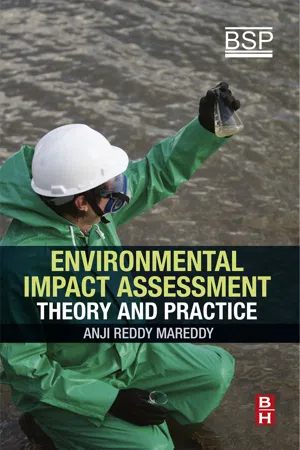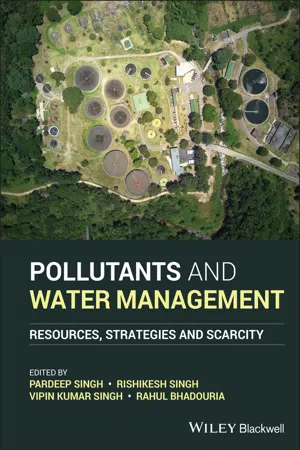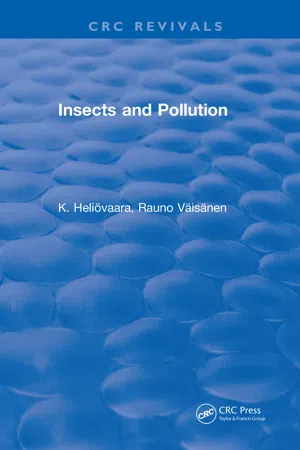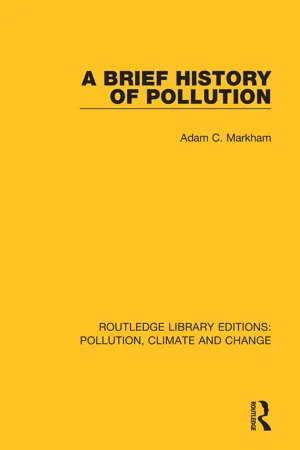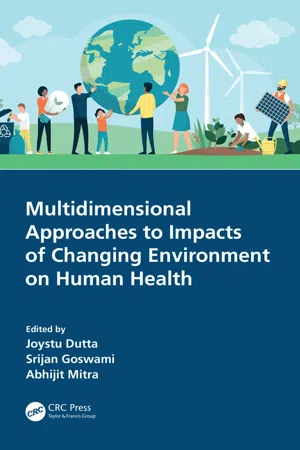Geography
Impact of Polluted Water
The impact of polluted water includes adverse effects on human health, ecosystems, and the economy. Contaminated water can lead to waterborne diseases, harm aquatic life, and disrupt food chains. Additionally, it can result in economic losses due to decreased agricultural productivity and increased healthcare costs.
Written by Perlego with AI-assistance
6 Key excerpts on "Impact of Polluted Water"
Learn about this page
Index pages curate the most relevant extracts from our library of academic textbooks. They’ve been created using an in-house natural language model (NLM), each adding context and meaning to key research topics.
- eBook - ePub
Exploring Environmental Issues
An Integrated Approach
- David D. Kemp(Author)
- 2004(Publication Date)
- Routledge(Publisher)
Figure 8.8 ). The depth and extent of the sag depend upon such factors as the initial dissolved oxygen content of the stream, the BOD of the waste, the rate at which the waste is added, the flow rate and volume of the stream and its capacity for reaeration. Problems arise if new waste is added to the stream before the dissolved oxygen level has recovered and the sag is extended downstream. Although this can happen under natural conditions, it is most often associated with multiple sources of effluent from human activities, which effectively cause the deterioration of water quality along great lengths of the river or stream.These physical, chemical and biological indicators point to aspects of water quality that may place constraints on specific uses. Such constraints may have natural origins, but since the middle of the nineteenth century the main problems have arisen as a result of pollution associated with human activities.Figure 8.8 The oxygen sag curve associated with the disposal of effluent into a waterwayWATER POLLUTION: SOURCES, IMPACTS AND SOLUTIONS
Within the aquatic environment there are processes capable of dealing with and neutralizing almost any contaminant added to it. They may be physical, chemical or biological in nature, or a combination of all three, and without them the earth's water would quickly become unable to fulfil its various functions in the environment. Their ability to maintain water quality is not unlimited, however, and in many areas they have been overwhelmed, causing normal aquatic processes to be adversely affected. When that point is reached, a water body is considered to be polluted. The number of potential water pollutants is almost infinite, but since current contaminants come overwhelmingly from human sources, they are frequently categorized according to the human activities that produced them. Accordingly, they will be considered here in terms of their origins in urban/domestic, agricultural and industrial activities (Figure 8.9 ).URBAN/DOMESTIC SOURCES, IMPACTS AND SOLUTIONS
The main source of pollution in urban areas is waste water or sewage produced as a result of domestic and industrial activities that is allowed to drain into adjacent water bodies. The industrial contribution depends very much upon the nature of the industry involved, but the contents of domestic waste water are remarkably similar in urban areas around the world. They are predominantly organic, including human waste, detergents or other cleansers and grey water, which does not contain the products of bodily functions, being mainly the result of bathing, showering and washing. Domestic sewage is a ubiquitous pollutant, which continues to be released untreated into the world's waterways, disrupting the aquatic environment through its impact on the biochemical oxygen demand, causing health problems and constraining the human use of rivers and lakes. In the past, when sewage volumes remained small, the environment was able to neutralize the contaminants, through oxidation and the activities of a variety of microorganisms that broke them down into less noxious by-products. As populations grew and lifestyles and technology changed, the volume of sewage increased and the natural approach was no longer - eBook - ePub
Environmental Impact Assessment
Theory and Practice
- Anji Reddy Mareddy(Author)
- 2017(Publication Date)
- Butterworth-Heinemann(Publisher)
6Impacts on water environment
Abstract
Water pollution, causes of water pollution, types of water pollutants with respect to water quality, and standards for water consumption are given in this chapter. In this chapter, the different types of water, both surface and groundwater quality, their contamination, and their impacts are presented. In the later part of chapter, the existing water environment is described focusing on impact prediction and impact assessment, and mitigation measures for maintaining water environment are provided. The wastewater management practice is also presented with a case study on common effluent treatment plant (CETP).Keywords
Point and nonpoint sources of water pollution; Water quality; Wastewater management; Common effluent treatment plant (CETP)Although 71% of the earth's surface is covered by water, only a tiny fraction of the water is available to us as freshwater. About 97% of the total water available on earth is found in the oceans and is too salty for drinking or irrigation. The remaining 3% is freshwater. Of this, 2.997% is locked in ice caps or glaciers. Thus, only 0.003% of the earth's total volume of water is easily available to us as soil moisture, groundwater, water vapor and water in lakes, streams, rivers, wetlands, and estuarine regions.In short, if the world's water supply were only 100 L, our usable supply of freshwater would be only about 0.0003 L (one-half teaspoon). This makes water a very precious resource. The future wars in our world may well be fought over water. By the middle of this century, almost twice as many people will be trying to share the same amount of freshwater the earth has today. In the future, as freshwater becomes scarcer, the access to water resources will be an important factor in determining the economic growth of several countries around the world. When the quality or composition of water changes directly or indirectly as a result of men's activities such that it becomes unfit for any purpose, it is said to be polluted. When a source of pollution can be readily identified because it has a definite source and place where it enters the water, it is said to come from a point source, for example, municipal and industrial discharge pipes. When a source of pollution cannot be readily identified, such as agricultural runoff and acid rain, they are said to be nonpoint sources of pollution. - eBook - ePub
Pollutants and Water Management
Resources, Strategies and Scarcity
- Pardeep Singh, Rishikesh Singh, Vipin Kumar Singh, Rahul Bhadouria, Pardeep Singh, Rishikesh Singh, Vipin Kumar Singh, Rahul Bhadouria(Authors)
- 2021(Publication Date)
- Wiley-Blackwell(Publisher)
The existence of plants, animals, and humans on Earth depends on nature playing an important role in providing water (Sharma et al. 2016). Rivers, lakes, and reservoirs are a major source of water in India. Some 80% of India's population is dependent on 14 major rivers for food and their livelihood. A growing population, accelerating industrialization, intensification of agriculture, and expanding urbanization exert heavy pressure on our vast but limited water resources. Despite so many priceless advantages, it is a poorly managed resource (Nwankwoala and Nwagbogwu 2012) because of its easy availability at a low cost. Both surface and groundwater resources are under stress. The increase in the growth rate of industrialization and urbanization created an unconstructive and adverse impact on water resources. The main reasons of water pollution are: (i) soil weathering; (ii) decomposition of organic materials; and (iii) untreated or not efficiently treated discharge effluent from industries, sewage, and municipal waste. From these mentioned causes, industrial pollution is considered as one of the factors causing the degradation of water quality (Järup 2000). Water discharge from industries and households carries chemicals and biological matter, which leads to an increase in demands on oxygen (DO) present in water, thereby reducing the level of DO due to biological oxygen demand (BOD) and chemical oxygen demand (COD) (Afzal et al. 2018). In developing countries like India, the major contributors to water pollution are the endpoints of effluents released from industries. Contaminated wastewater released from industrial areas creates negative impacts on human health and also makes the soil quality unsuitable for irrigation purposes and crops. So, it becomes crucially important to access the quality of water before directly discharging it into the environment (Bharti et al. 2013) - eBook - ePub
- K. Heliovaara(Author)
- 2018(Publication Date)
- CRC Press(Publisher)
1148 Recently, water pollution levels have decreased in some North American and European waters. However, this is not the global trend. In eastern Europe and in Russia, as well as in several developing countries, the situation is unsatisfactory. The distribution of industry and human population as well as hydrological conditions affect the consequences. Since Chapter 5 deals with water pollution, only some notes are given here.Plant nutrient levels in waters are often elevated by the urbanization process and discharge of nutrients from agricultural areas (as well as by discharges from agricultural areas). Phosphorus and nitrogen losses from urbanized watersheds may be two to ten times greater than those from forested watersheds. These nutrients may stimulate algal growth in urban streams, leading to changes in aquatic food webs. Levels of metals, toxic organic compounds, and road salt, all of which may be damaging to aquatic life, are greatly enhanced in streams draining urbanized areas. Urbanization of a watershed may significantly alter stream water quality even in the absence of direct industrial or municipal discharges. Suspended sediment loads from streams draining urban areas are often much greater than those from nearby forested watersheds. Suspended sediments from construction activities can adversely affect aquatic life through habitat elimination under heavy loading or by interference with feeding under lighter stress. Other factors associated with urbanization may also alter the hydrology of watersheds. The increase in the impervious surface area and drainage networks has resulted in a substantial increase in the proportion of rainfall that is rapidly discharged from the watershed as direct runoff and streamflow. The volume of flood flow increases, and there is a decrease in low flow volume during nonstorm periods. The decrease in low flow discharges decreases the available stream habitat, increases the likelihood that the stream may dry up, may increase diurnal temperature fluctuations, and increases the concentration of pollutants due to a lack of dilution. The increase in flood flow causes enhanced erosion and scouring.796 - eBook - ePub
- Adam C. Markham(Author)
- 2019(Publication Date)
- Routledge(Publisher)
Chapter FiveWATER POLLUTION AND CHEMICAL CONTAMINATION
Verily, a muddy stream is man. One must be a sea to be able to receive a muddy stream without becoming unclean. Friedrich NietzscheNot so Pure
Water is the life-giver and the hydrological cycle is central to human existence. As surely as rain falls on the land, so too must much of it drain into the oceans. People have understood the importance of water for millenia, and yet it is one of the most abused and exploited substances on our planet. Adam Smith noted ‘Nothing is more useful than water; but it will purchase scarce anything; scarce anything can be had in exchange for it.’125In 1977, the UN Water Conference in La Plata declared that ‘all peoples have the right to have access to drinking water in quantities and of a quality equal to their basic need’.126 Despite the fact that there is more than enough water on the planet to meet this objective, water pollution and scarcity have been throughout history, and remain today, one of humankind’s most intractable problems.The politics of clean water really took off in 1854, after John Snow demonstrated a clear link between sewage leaking into London’s Broad Street well and cholera outbreaks in the city. Eventually, better management of municipal sewage, sand filtration techniques and water chlorination followed this discovery, making drinking water supplies safe in most developed countries by the early twentieth century. In these countries the new freshwater pollution problems of oxygen depletion, eutrophication, heavy metal contamination, acidification, toxic chemicals and nitrates began to be manifested from the 1950s onwards.127While these problems are all, to one degree or other, present also in developing countries, it is human sewage which remains the most important pollutant of their freshwaters and coastal zones. A World Health Organization report published in 1992 found waterborne infections (such as cholera, diarrhoeal diseases, typhoid and poliomyelitis) to be the ‘largest single category of communicable diseases contributing to infant mortality in developing countries.’128 These diseases kill four million children and a million adults every year. Schistosomiasis or bilharzia, a parasitic disease of the bladder and intestines spread by pollution of watercourses by human excreta, affects a further 200 million people in the tropics.129 - Joystu Dutta, Srijan Goswami, Abhijit Mitra, Joystu Dutta, Srijan Goswami, Abhijit Mitra(Authors)
- 2021(Publication Date)
- CRC Press(Publisher)
Figure 2.1 also shows that as socioeconomic conditions change the hazards also change from being local to being global. Heavy particulate matter air pollution, water pollution, and household waste have a more localised effect, where people share the same water source and the same air which may be polluted by factories and indiscriminate and mismanaged disposal and at times burning of garbage.FIGURE 2.1 Change in environmental profile with changing per capita gross national product (GNP) (McMichael et al., 2003 ).As society moves up in per capita gross national product reaching middle-income levels, the causes for environmental degradation also shift to CFC-based pollution, fine particulate matter air pollution, and heavy-metal contamination in water sources, soil, and even air. These effects manifest at larger scales like nations and continental and sub-continental regions. At higher levels of income, the other causes of environmental change give way to GHG-based stresses on our biosphere which result in an increase in global temperature, depletion in habitat and resources, and unpredictability of extreme weather events. These effects are at the largest scales affecting the entire biosphere of the planet, both terrestrial and aquatic. McMichael mentions that these effects moved chronologically, with the local effects manifesting during industrialisation, regional effects taking hold during the period of economic boom when society experiences economic development, and global effects taking hold when society has achieved higher living standards with higher GHG emissions (McMichael et al., 2003). These effects can be seen to exist currently amongst various countries. A country like India may see all these three categories coexisting. Category A is visible in slums, industrial peri-urban regions, and poorer settlements. Category B can be seen in regions with higher levels of construction, driven mostly by increasing incomes and levels of consumption. Category C has a greater effect and has grown together with living conditions. Excessive use of fossil fuels and using materials with a high GHG emission footprint have contributed to the growth of category C. A big reason behind the growth of Category C, according to McMichael, is the shift away from conditions that caused environmental degradation under Categories A and B. This transition can be seen in countries which are currently in their developing stages. In countries with steady-state growth and developed socioeconomic indicators, which have moved away from Categories A and B, the impact of Category C is becoming more visible. This coexistence of multiple categories of climatic and environmental change has heterogeneous impacts across the globe, with stark differences between the effects of environmental change on low-income nations versus high-income nations (25% versus 17% of deaths related to environmental change respectively) (McMichael, Nyong, & Corvalan, 2008

